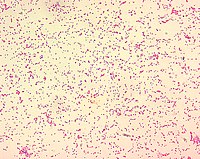
Photo from wikipedia
Mediterranean spotted fever (MSF) is an emerging tick-borne rickettsiosis of the spotted fever group (SFG), endemic in the Mediterranean basin. By virtue of technological innovations in molecular genetics, it has… Click to show full abstract
Mediterranean spotted fever (MSF) is an emerging tick-borne rickettsiosis of the spotted fever group (SFG), endemic in the Mediterranean basin. By virtue of technological innovations in molecular genetics, it has been determined that the causative agent of MSF is Rickettsia conorii subspecies conorii. The arthropod vector of this bacterium is the brown dog tick Rhipicephalus sanguineus. The true nature of the reservoir of R. conorii conorii has not been completely deciphered yet, although many authors theorize that the canine population, other mammals, and the ticks themselves could potentially contribute as reservoirs. Typical symptoms of MSF include fever, maculopapular rash, and a characteristic eschar (“tache noire”). Atypical clinical features and severe multi-organ complications may also be present. All of these manifestations arise from the disseminated infection of the endothelium by R. conorii conorii. Several methods exist for the diagnosis of MSF. Serological tests are widely used and molecular techniques have become increasingly available. Doxycycline remains the treatment of choice, while preventive measures are focused on modification of human behavior and vector control strategies. The purpose of this review is to summarize the current knowledge on the epidemiology, pathogenesis, clinical features, diagnosis, and treatment of MSF.
Journal Title: Tropical Medicine and Infectious Disease
Year Published: 2021
Link to full text (if available)
Share on Social Media: Sign Up to like & get
recommendations!